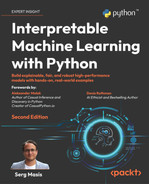A deep and detailed dive into the key aspects and challenges of machine learning interpretability, complete with the know-how on how to overcome and leverage them to build fairer, safer, and more reliable models Do you want to gain a deeper understanding of your models and better mitigate poor prediction risks associated with machine learning interpretation? If so, then Interpretable Machine Learning with Python, Second Edition is the book for you. You’ll cover the fundamentals of interpretability, its relevance in business, and explore its key aspects and challenges. See how white-box models work, compare them to black-box and glass-box models, and examine their trade-offs. Get up to speed with a vast array of interpretation methods, also known as Explainable AI (XAI) methods, and how to apply them to different use cases, be it for classification or regression, tabular data, time-series, images, or text. In addition to the step-by-step code, this book will also help you interpret model outcomes using many examples. You’ll get hands-on with tuning models and training data for interpretability by reducing complexity, mitigating bias, placing guardrails, and enhancing reliability. The methods you’ll explore here range from state-of-the-art feature selection and dataset debiasing methods to monotonic constraints and adversarial retraining. You’ll also look under the hood of the latest NLP transformer models using the Language Interpretability Tool. By the end of this book, you'll understand ML models better and enhance them through interpretability tuning. This book is for data scientists, machine learning developers, MLOps engineers, and data stewards who have an increasingly critical responsibility to explain how the AI systems they develop work, their impact on decision making, and how they identify and manage bias It’s also a useful resource for self-taught ML enthusiasts and beginners who want to go deeper into the subject matter, though a good grasp of the Python programming language is needed to implement the examples.Key Features
Book Description
What you will learn
Who this book is for
Table of Contents
- Interpretable Machine Learning with Python, Second Edition: Build Your Own Interpretable Models
- 1 Interpretation, Interpretability, and Explainability; and Why Does It All Matter?
- 2 Key Concepts of Interpretability
- 3 Interpretation Challenges
- 5 Local Model-Agnostic Interpretation Methods
- 6 Anchor and Counterfactual Explanations
- 9 Interpretation Methods for Multivariate Forecasting and Sensitivity Analysis
- 10 Feature Selection and Engineering for Interpretability
- 14 What's Next for Machine Learning Interpretability?
